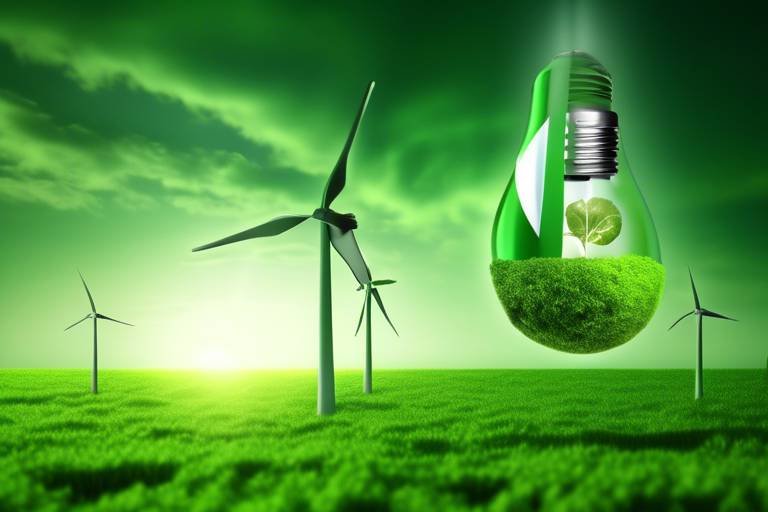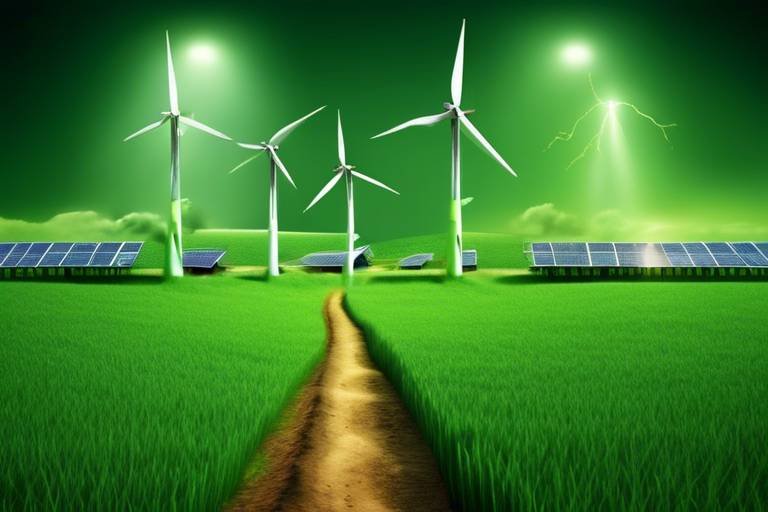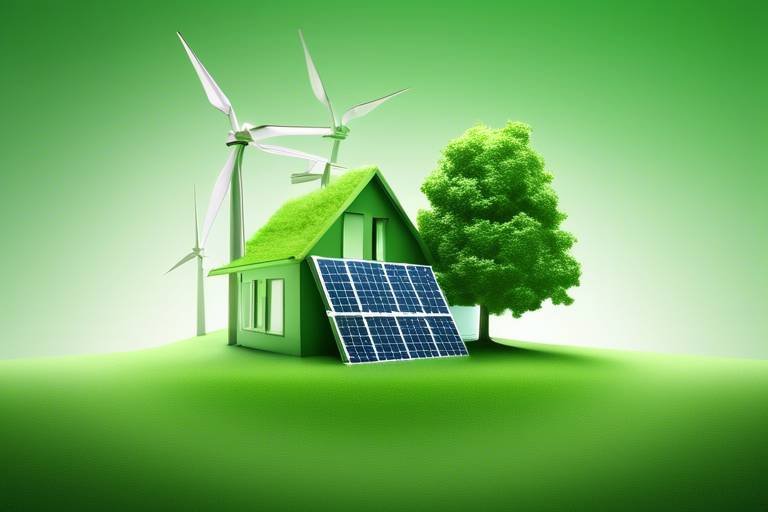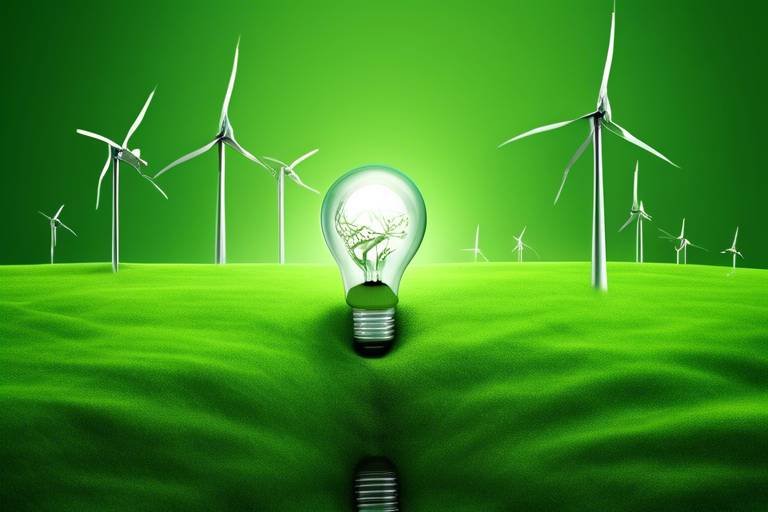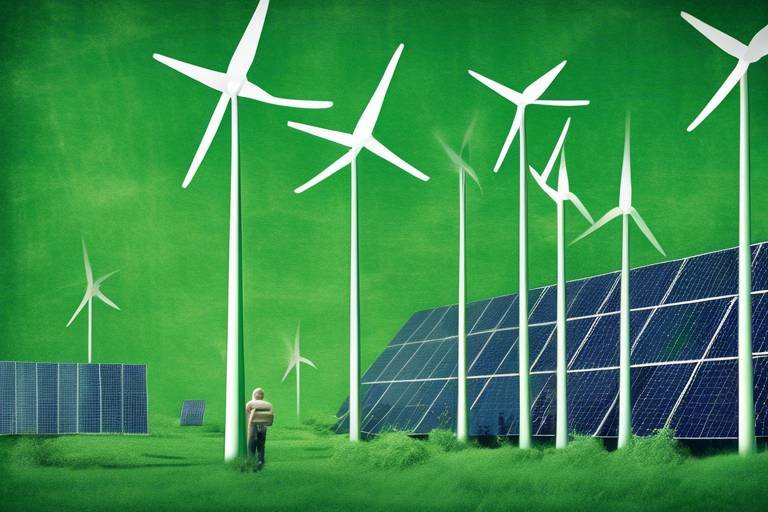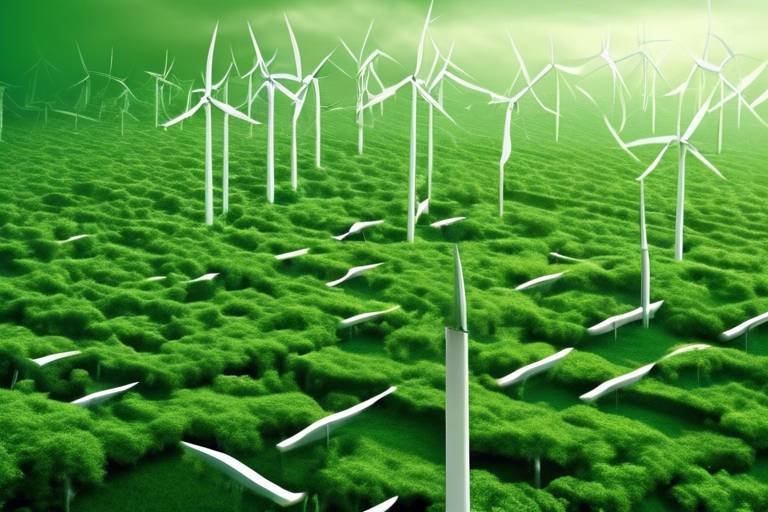How to Reduce Your Carbon Footprint with Green Energy
In today's world, where climate change is no longer a distant threat but a pressing reality, reducing your carbon footprint has become more important than ever. Adopting green energy solutions is one of the most effective ways to make a positive impact on the planet. But what does it really mean to reduce your carbon footprint, and how can you get started? This article will explore practical steps that both individuals and businesses can take to embrace renewable energy and contribute to a more sustainable future.
A carbon footprint measures the total greenhouse gas emissions caused directly and indirectly by an individual, organization, or product. It's like a shadow that follows us around, reflecting our environmental impact. Understanding this concept is crucial for identifying areas where green energy can make a significant impact. For example, did you know that the average person contributes approximately 16 tons of carbon dioxide to the atmosphere each year? That's like filling up a hot air balloon with pollution! By switching to renewable energy sources, you can significantly reduce this number and help lighten your environmental load.
Green energy offers numerous advantages that go beyond just being eco-friendly. Transitioning to renewable energy sources can lead to reduced greenhouse gas emissions, lower energy bills, and enhanced energy security. Imagine waking up every morning knowing that your home is powered by the sun or the wind! Not only does this help the planet, but it can also keep more money in your pocket. Plus, with energy prices fluctuating, having a renewable energy source can provide you with greater stability and predictability in your energy costs.
There are various forms of green energy, each with its unique characteristics, benefits, and applications. Understanding these differences is essential when choosing a renewable energy source that suits your needs. The most common types include:
- Solar Energy: Harnesses sunlight using photovoltaic cells to generate electricity.
- Wind Energy: Captures kinetic energy from the wind using turbines.
- Hydroelectric Energy: Uses flowing water to generate power.
- Geothermal Energy: Utilizes heat from beneath the Earth's surface.
Solar energy is one of the most accessible forms of renewable energy. By installing solar panels on your roof, you can harness the power of the sun to generate electricity for your home. The technology behind solar panels has advanced significantly, making them more efficient and affordable than ever. Not only do solar panels reduce your reliance on fossil fuels, but they also offer the potential for significant savings on your energy bills. Imagine receiving a check from your utility company because you produced more energy than you consumed!
Wind energy captures the kinetic energy from the wind using turbines to produce electricity. Wind farms, often located in open areas where wind is plentiful, play a crucial role in reducing carbon emissions on a larger scale. When you think about it, harnessing the wind is like catching a free ride on a natural rollercoaster! The energy produced can be used to power homes, businesses, and even entire cities, making it a vital part of the green energy puzzle.
Transitioning to green energy at home can significantly lower your carbon footprint. Here are a few practical tips for homeowners looking to incorporate renewable energy sources into their daily lives:
- Consider installing solar panels or a solar water heating system.
- Invest in energy-efficient appliances to reduce overall consumption.
- Explore options for community solar programs if individual installation isn't feasible.
- Participate in green energy programs offered by your utility company.
By taking these steps, you not only contribute to a healthier planet but also create a more sustainable environment for future generations.
Many governments around the world offer incentives to encourage the adoption of green energy technologies. These can include tax credits, rebates, and grants that help offset the costs of transitioning to renewable energy. For instance, in the United States, the federal solar tax credit allows homeowners to deduct a significant percentage of the cost of solar panel installation from their federal taxes. This makes going green not just a smart choice for the planet, but a financially savvy one as well.
Community-based renewable energy projects can foster collective action towards sustainability. By engaging local residents, these initiatives promote the use of green energy on a communal level. Examples include community solar gardens, where neighbors pool resources to invest in solar panels, or local wind farms that provide energy for the entire community. These projects not only reduce the carbon footprint but also strengthen community bonds, proving that together, we can achieve more.
The future of green energy looks promising, with advancements in technology and increased awareness driving its adoption. Innovations such as improved battery storage, smart grids, and more efficient renewable technologies are paving the way for a cleaner, greener future. As we continue to embrace these changes, the potential for a sustainable energy landscape becomes more attainable. Just think about it: a world where our energy comes from clean, renewable sources is not just a dream; it’s a reality we can create together.
Q: What is a carbon footprint?
A: A carbon footprint is the total amount of greenhouse gases emitted directly or indirectly by an individual or organization.
Q: How can I reduce my carbon footprint at home?
A: You can reduce your carbon footprint by using energy-efficient appliances, installing solar panels, and using public transport or carpooling.
Q: Are there financial incentives for using green energy?
A: Yes, many governments offer tax credits, rebates, and grants to help offset the costs of renewable energy installations.
Q: What types of green energy are available?
A: The most common types include solar, wind, hydroelectric, and geothermal energy.

Understanding Carbon Footprint
A carbon footprint is more than just a buzzword; it's a crucial concept that helps us understand our impact on the planet. Essentially, it measures the total greenhouse gas emissions caused directly and indirectly by an individual, organization, or product. Think of it as your environmental shadow—wherever you go and whatever you do, your carbon footprint follows you. It’s important to grasp this idea because it allows us to pinpoint areas where we can make meaningful changes, particularly through the adoption of green energy solutions.
When we talk about greenhouse gases, we’re primarily referring to carbon dioxide (CO2), methane (CH4), and nitrous oxide (N2O), which are released through various activities such as driving cars, using electricity, and even producing food. For instance, the average American's carbon footprint is estimated to be around 16 tons of CO2 per year. This staggering number can seem overwhelming, but it also presents an incredible opportunity for change. By understanding what contributes to our carbon footprint, we can take actionable steps to reduce it.
To break it down further, the carbon footprint can be categorized into two main components: direct emissions and indirect emissions. Direct emissions come from sources that you control, like your car or your home heating system. On the other hand, indirect emissions are those that are produced in the process of making the goods and services you consume. For example, the energy used to manufacture your smartphone or the emissions from the transportation of your groceries can contribute to your overall footprint.
| Emission Sources | Direct Emissions | Indirect Emissions |
|---|---|---|
| Transportation | Car fuel consumption | Public transport emissions |
| Home Energy | Heating and cooling | Electricity production |
| Food | Meat production | Food transportation |
Understanding your carbon footprint is not just about numbers; it’s about awareness and responsibility. By tracking your emissions, you can identify the biggest culprits in your lifestyle and make informed choices that align with a greener future. For instance, if you discover that your transportation habits are a significant contributor, you might consider carpooling, using public transport, or even switching to an electric vehicle.
Moreover, there are several tools available online that can help you calculate your carbon footprint. These calculators often ask questions about your daily habits, such as how much you drive, your energy consumption, and your dietary choices. The results can be eye-opening and serve as a wake-up call to many. Remember, every small change counts. Whether it's choosing to walk instead of drive or reducing meat consumption, these decisions collectively contribute to a more sustainable world.
In summary, understanding your carbon footprint is the first step towards making impactful changes in your life. By recognizing the sources of your emissions and their effects on the environment, you can take steps to reduce your footprint significantly. The journey towards sustainability begins with awareness, and the more you know, the better equipped you are to make choices that benefit both you and the planet.

Benefits of Green Energy
Transitioning to green energy is not just a trend; it's a transformative movement that benefits both the planet and our wallets. Imagine a world where your energy choices not only keep your lights on but also contribute to a healthier environment. By adopting renewable energy sources, you can significantly reduce your carbon footprint, leading to a myriad of benefits. Let's delve into some of the most compelling advantages of embracing green energy.
One of the most immediate benefits of green energy is the substantial reduction in greenhouse gas emissions. Traditional energy sources, like fossil fuels, release a significant amount of carbon dioxide and other harmful gases into the atmosphere. In contrast, renewable energy sources such as solar, wind, and hydroelectric power generate electricity without emitting these pollutants. This shift not only helps combat climate change but also improves air quality, leading to better health outcomes for communities.
Additionally, switching to green energy can lead to lower energy bills. Although the initial investment in renewable energy technology, such as solar panels, can be high, the long-term savings are undeniable. Once installed, solar panels can drastically reduce or even eliminate your electricity bills. Furthermore, many regions offer net metering programs, allowing homeowners to sell excess energy back to the grid, turning your home into a mini power plant!
Another significant advantage is the enhancement of energy security. By relying on locally sourced renewable energy, countries can reduce their dependence on imported fuels, which can be subject to volatile prices and supply disruptions. This not only stabilizes energy costs but also strengthens national security by decreasing vulnerability to foreign energy market fluctuations.
Moreover, the transition to green energy creates job opportunities in emerging industries. The renewable energy sector is one of the fastest-growing job markets, with positions ranging from solar panel installation to wind turbine maintenance. According to recent studies, investing in green technology can create more jobs per unit of electricity generated compared to fossil fuels. This means that not only are we saving the planet, but we're also boosting the economy!
Lastly, adopting green energy contributes to a more sustainable future for generations to come. By reducing our reliance on non-renewable resources, we are ensuring that future generations inherit a planet that is thriving, not just surviving. It's not just about us; it's about creating a legacy of sustainability.
In summary, the benefits of green energy are profound and far-reaching. From reducing greenhouse gas emissions and lowering energy bills to enhancing energy security and creating job opportunities, the advantages are clear. So, why not take the plunge into the world of renewables? Your wallet, your health, and the planet will thank you!
- What is green energy? Green energy refers to energy derived from renewable, natural sources that are replenished at a faster rate than they are consumed, such as solar, wind, and hydroelectric power.
- How does green energy reduce my carbon footprint? By using renewable sources instead of fossil fuels, green energy significantly lowers the amount of greenhouse gases released into the atmosphere.
- Are there any financial incentives for switching to green energy? Yes! Many governments offer tax credits, rebates, and grants to encourage the adoption of renewable energy technologies.
- Can I install solar panels on my home? Absolutely! Many homeowners are successfully installing solar panels to harness solar energy, often with financial incentives to help offset costs.

Types of Green Energy
When we talk about green energy, we’re diving into a treasure trove of renewable energy sources that not only promise to reduce our carbon footprint but also offer sustainable solutions for our growing energy needs. Each type of green energy comes with its own unique characteristics, benefits, and applications, making it crucial to understand these differences when considering a transition to renewable energy.
Let’s start with solar energy. This powerhouse harnesses sunlight through photovoltaic cells, converting it into electricity that can power our homes, schools, and businesses. Imagine your roof as a mini power plant, soaking up the sun’s rays and transforming them into clean energy. The technology behind solar panels has advanced significantly, making them more efficient and affordable than ever. With government incentives and falling installation costs, now is the perfect time to explore how solar energy can benefit your household.
Next up is wind energy. Have you ever stood on a hill and felt the wind whip through your hair? That wind can be captured using turbines to produce electricity. Wind farms, often located in open fields or offshore, are a sight to behold, with their towering turbines spinning gracefully in the breeze. These farms not only provide a substantial amount of energy but also play a crucial role in reducing carbon emissions on a larger scale. The kinetic energy from the wind is converted into mechanical energy, which is then transformed into electrical energy, powering everything from homes to entire cities.
Then we have hydroelectric energy, which harnesses the power of flowing water. Picture a river cascading down a mountainside; that movement can be captured by dams to generate electricity. Hydroelectric power is one of the most widely used forms of renewable energy, providing a reliable source of energy while also managing water resources. However, it’s essential to consider the environmental impact of damming rivers, as it can disrupt local ecosystems.
Another fascinating type of green energy is geothermal energy. This method taps into the Earth’s internal heat, which can be harnessed for heating and electricity generation. Think of it as utilizing the planet’s natural furnace. Geothermal energy is particularly effective in regions with volcanic activity, where the heat from the Earth can be accessed more easily. It’s a stable and reliable energy source, capable of providing consistent power regardless of weather conditions.
To summarize, here’s a quick look at the four main types of green energy:
| Type of Green Energy | Description | Benefits |
|---|---|---|
| Solar Energy | Harnesses sunlight using photovoltaic cells. | Reduces electricity bills, low maintenance costs. |
| Wind Energy | Captures kinetic energy from wind using turbines. | Clean and renewable, scalable for large or small operations. |
| Hydroelectric Energy | Generates electricity by utilizing flowing water. | Reliable and efficient, can store energy in reservoirs. |
| Geothermal Energy | Uses heat from the Earth’s interior. | Consistent energy source, minimal land footprint. |
Understanding these types of green energy is the first step towards making informed decisions about how to reduce your carbon footprint. Whether you’re considering solar panels for your home or supporting wind farms in your community, each choice contributes to a cleaner, more sustainable future. So, which type of green energy resonates with you? The possibilities are exciting, and the impact is profound!
- What is green energy? Green energy refers to energy derived from natural sources that are replenished at a faster rate than they are consumed, such as solar, wind, hydroelectric, and geothermal energy.
- How does solar energy work? Solar energy works by converting sunlight into electricity using photovoltaic cells found in solar panels.
- Is wind energy reliable? Yes, wind energy is a reliable source of renewable energy, especially in areas with consistent wind patterns.
- What are the environmental impacts of hydroelectric power? While hydroelectric power is renewable, it can impact local ecosystems due to damming rivers and altering natural water flows.
- Can geothermal energy be used anywhere? Geothermal energy is most effective in regions with volcanic activity or hot springs, but advancements in technology are making it more accessible in other areas.

Solar Energy
Solar energy is one of the most accessible and promising forms of renewable energy available today. It harnesses the power of the sun, converting sunlight into electricity using photovoltaic (PV) cells. Imagine having a tiny power plant right on your rooftop, generating clean energy every time the sun shines! This technology has advanced tremendously over the years, making it more efficient and affordable for both residential and commercial use.
When you think about solar energy, consider the various components involved in the process. The solar panels, which are typically installed on rooftops or in open areas, capture sunlight and convert it into direct current (DC) electricity. This electricity then flows through an inverter, which transforms it into alternating current (AC) electricity, the type used in most homes. The beauty of this system is that it allows you to generate your own electricity, potentially reducing or even eliminating your electricity bills. How cool is that?
Implementing solar energy solutions in your home is not as daunting as it may seem. Here are some practical steps to get you started:
- Assess your energy needs: Understanding how much energy your household consumes will help you determine the size and number of solar panels required.
- Evaluate your roof: Ensure your roof is structurally sound and receives adequate sunlight throughout the day. South-facing roofs typically yield the best results.
- Research local incentives: Many regions offer tax credits, rebates, and other financial incentives to encourage solar energy adoption, making it more affordable.
- Choose a reputable installer: Look for solar installation companies with good reviews and experience to ensure your system is installed correctly.
One of the most exciting aspects of solar energy is its scalability. Whether you're a homeowner looking to power your house or a business aiming to reduce operational costs, solar solutions can be tailored to fit your needs. Additionally, as technology continues to evolve, solar panels are becoming more efficient and less obtrusive, making them an attractive option for a wider range of properties.
In conclusion, solar energy is not just a trend; it's a viable solution for reducing our carbon footprint and promoting sustainability. By harnessing the power of the sun, you can contribute to a cleaner, greener planet while enjoying the financial benefits of lower energy costs. So, why not take the plunge into solar energy and start making a difference today?
Q: How much does it cost to install solar panels?
A: The cost of solar panel installation can vary significantly based on the size of the system, location, and available incentives. However, many homeowners see a return on investment within 5 to 7 years through energy savings.
Q: Do solar panels work on cloudy days?
A: Yes, solar panels can still generate electricity on cloudy days, although their efficiency may be reduced. They are designed to capture indirect sunlight as well.
Q: What happens to excess energy generated by my solar panels?
A: Excess energy can often be fed back into the grid, and many utility companies offer net metering programs that credit you for this surplus energy, further reducing your energy costs.

Wind Energy
Wind energy is one of the most exciting and rapidly growing sources of renewable energy available today. By converting the kinetic energy of wind into electricity, wind turbines play a crucial role in reducing our reliance on fossil fuels and minimizing greenhouse gas emissions. Imagine standing on a hilltop, feeling the refreshing breeze against your face, while knowing that this very wind is being harnessed to power homes and businesses. It’s not just a breath of fresh air; it’s a revolution in energy production!
Wind turbines come in various shapes and sizes, but they all operate on the same basic principle: the wind turns the blades, which spins a rotor connected to a generator that produces electricity. This technology has evolved significantly over the years, making wind energy more efficient and cost-effective. In fact, the cost of wind energy has dropped dramatically, making it one of the most affordable forms of new electricity generation in many parts of the world.
But how does wind energy actually work? Here’s a simplified breakdown:
- Wind Turbines: These structures capture the wind's energy, converting it into mechanical energy.
- Generators: The mechanical energy from the turbine spins the generator, producing electricity.
- Power Grid: The generated electricity is then sent to the power grid, where it can be distributed to homes and businesses.
One of the most significant advantages of wind energy is its minimal environmental impact. Unlike traditional energy sources, wind energy does not produce air pollutants or greenhouse gases during operation. This makes it an essential player in the fight against climate change. Furthermore, wind farms can coexist with agricultural activities, allowing farmers to utilize their land for dual purposes—growing crops while generating clean energy.
Wind energy is not without its challenges, though. Some critics argue that wind farms can disrupt local wildlife and may be visually unappealing. However, advancements in technology and careful planning can mitigate these concerns. For instance, modern wind turbines are designed to be quieter and less intrusive, and many developers conduct thorough environmental assessments before establishing wind farms.
As we look to the future, the potential for wind energy is vast. Innovations in turbine design, such as floating wind farms, are opening up new possibilities for harnessing wind energy in deeper waters where winds are stronger and more consistent. This could lead to a significant increase in the amount of clean energy generated from wind.
In summary, wind energy holds tremendous promise as a sustainable energy source. By investing in wind technology and supporting the development of wind farms, we can take significant steps toward reducing our carbon footprint and creating a cleaner, greener planet for future generations. So next time you feel the wind at your back, remember that it could be powering your home!
Q1: How much energy can a wind turbine produce?
A: The amount of energy produced by a wind turbine depends on its size and the wind speed. On average, a single turbine can generate enough electricity to power approximately 500 to 800 homes annually.
Q2: Are wind farms noisy?
A: While wind turbines do produce some noise, advancements in technology have significantly reduced their sound levels. Most people living near wind farms report that the noise is comparable to that of a refrigerator.
Q3: What happens when the wind doesn't blow?
A: Wind energy is intermittent, meaning it doesn't produce electricity all the time. However, wind energy is often complemented by other energy sources, and advancements in energy storage technologies are improving reliability.
Q4: Can wind energy be harnessed offshore?
A: Yes! Offshore wind farms are increasingly popular as they can take advantage of stronger and more consistent winds found over the ocean.

Adopting Green Energy at Home
Transitioning to green energy at home is not just a trend; it's a lifestyle choice that can significantly lower your carbon footprint while also saving you money. Imagine waking up every morning knowing that your energy consumption is not harming the planet. Sounds great, right? By making simple changes in your home, you can harness the power of renewable energy sources and contribute to a more sustainable future.
First off, one of the most popular ways to adopt green energy at home is through solar panels. These nifty devices convert sunlight into electricity, allowing you to power your home with clean energy. Installing solar panels might seem like a hefty investment at first, but think of it as planting a tree; it requires some effort upfront, but the benefits grow over time. Many homeowners see a significant reduction in their energy bills, and depending on your location, you might even be eligible for government incentives that can help offset installation costs.
Another fantastic option for reducing your carbon footprint is to consider wind energy. While not every home has the space for a wind turbine, if you live in a suitable area, this can be an excellent way to generate your own electricity. Wind turbines work by capturing the kinetic energy of the wind and converting it into electrical energy. Just like solar energy, investing in wind energy can lead to long-term savings and a reduced reliance on fossil fuels.
If you're not ready to install solar panels or wind turbines, don’t worry! There are still plenty of simple changes you can make. For instance, consider switching to energy-efficient appliances. These appliances use less energy, which means lower bills and less strain on the environment. Look for products with the ENERGY STAR label; they meet strict energy efficiency guidelines set by the U.S. Environmental Protection Agency.
Additionally, you can reduce your energy consumption by making small adjustments in your daily habits. For example:
- Turn off lights when you leave a room.
- Unplug devices when they are not in use to avoid phantom energy drain.
- Use a programmable thermostat to optimize heating and cooling.
By incorporating these practices into your lifestyle, you can make a substantial impact on your energy consumption. Furthermore, consider joining or forming a community solar program. These initiatives allow multiple households to benefit from a shared solar energy system, making renewable energy accessible to those who may not be able to install solar panels on their own properties.
In conclusion, adopting green energy at home is not just about installing solar panels or wind turbines; it's about embracing a mindset of sustainability. Every little change counts and contributes to a larger movement towards a cleaner, greener planet. So, why not take the plunge? Your future self—and the Earth—will thank you!
1. What is the easiest way to start using green energy at home?
The easiest way to start is by switching to energy-efficient appliances and making small changes to your daily habits, such as turning off lights and unplugging devices.
2. Are there financial incentives for installing solar panels?
Yes, many governments offer tax credits, rebates, and grants to help offset the costs of installing solar panels, making it more affordable.
3. Can I use wind energy at home?
If you live in an area with sufficient wind resources, installing a small wind turbine can be a great way to generate your own energy. However, it's essential to check local regulations and zoning laws.
4. How can I participate in community solar programs?
Look for local solar co-ops or community solar initiatives in your area. These programs allow you to invest in a shared solar project and receive credits on your electricity bill.

Government Incentives for Green Energy
As the world increasingly recognizes the importance of sustainability, many governments are stepping up to promote the use of green energy through a variety of incentives. These incentives can come in many forms, including tax credits, rebates, and grants, all designed to make the transition to renewable energy sources more affordable for individuals and businesses alike. By understanding these incentives, you can significantly reduce the initial costs associated with adopting green technologies.
For instance, in the United States, the federal government offers the Investment Tax Credit (ITC), which allows homeowners and businesses to deduct a significant percentage of their solar energy system costs from their federal taxes. This can lead to substantial savings, making solar panels much more accessible. Similarly, many states provide additional incentives, such as rebates for installing solar panels or wind turbines, which can further decrease the overall cost.
In addition to tax credits, some governments also offer grants to encourage the development of renewable energy projects. These grants can help cover the costs of installing energy-efficient systems, such as geothermal heating or high-efficiency appliances. Moreover, local utility companies may provide incentive programs that reward customers for reducing their energy usage or for participating in demand response programs. These programs not only help you save money but also contribute to a more stable and sustainable energy grid.
To illustrate the impact of these incentives, consider the following table showcasing some common government incentives available in various regions:
| Incentive Type | Description | Example Region |
|---|---|---|
| Tax Credit | Deduction from taxes based on renewable energy investment. | United States |
| Rebate | Cash back for purchasing renewable energy systems. | California |
| Grant | Funding to support renewable energy projects. | Europe |
| Low-Interest Loans | Loans with reduced interest rates for energy-efficient upgrades. | Canada |
It's important to note that these incentives can vary significantly depending on your location and the specific renewable energy technology you choose to implement. Therefore, it’s a good idea to research local programs and consult with energy experts to maximize your benefits. Additionally, many non-profit organizations and community groups offer resources and guidance on navigating these incentives, ensuring you don’t miss out on potential savings.
In conclusion, government incentives play a crucial role in facilitating the adoption of green energy solutions. By taking advantage of these programs, you can not only reduce your carbon footprint but also save money in the long run. So, whether you're a homeowner looking to install solar panels or a business aiming to transition to renewable energy, make sure to explore the various incentives available in your area. The journey toward sustainability is not just beneficial for the planet; it's also a smart financial decision!
- What types of government incentives are available for green energy? Incentives can include tax credits, rebates, grants, and low-interest loans.
- How do I find out what incentives are available in my area? Research local government websites, utility companies, and non-profit organizations for information on available programs.
- Can I combine multiple incentives? Yes, in many cases, you can stack incentives from different sources to maximize your savings.

Community Initiatives
Community initiatives play a pivotal role in fostering sustainable practices and promoting the use of green energy at a grassroots level. These initiatives not only bring together local residents but also empower them to take collective action towards reducing their carbon footprint. Imagine a neighborhood where everyone is on board with the idea of going green—it's like a symphony where each instrument contributes to a beautiful harmony of sustainability!
One of the most effective ways communities are embracing green energy is through solar co-ops. These cooperatives allow residents to pool their resources to install solar panels at a reduced cost. By working together, they can negotiate better deals with solar providers and share the benefits of clean energy. It's a win-win situation: lower costs for participants and a significant reduction in the community's overall carbon emissions. For instance, a solar co-op in a small town can lead to a collective installation of hundreds of solar panels, drastically cutting down reliance on fossil fuels.
Additionally, community gardens powered by renewable energy sources are becoming increasingly popular. These gardens not only provide fresh produce but also serve as a platform for educating community members about sustainable practices. Imagine walking through a vibrant garden, buzzing with activity, where children learn about composting and adults share tips on energy conservation—all while being powered by the sun or wind!
Moreover, many communities are launching green energy workshops to educate residents about the benefits and implementation of renewable energy technologies. These workshops often cover various topics, including:
- Understanding solar panel installation
- Exploring wind energy options
- Learning about energy efficiency in homes
By participating in these workshops, residents gain valuable knowledge that they can apply in their own lives, creating a ripple effect of sustainable practices throughout the community.
Another exciting aspect of community initiatives is the establishment of local renewable energy projects. These projects can range from small-scale wind turbines to larger solar farms, all designed to meet the energy needs of the community while minimizing environmental impact. When communities invest in such projects, they not only create jobs but also foster a sense of ownership and pride in their local environment.
In conclusion, community initiatives are a powerful tool for promoting green energy and sustainability. By coming together, individuals can make a significant impact on their environment while enjoying the benefits of cleaner energy. So, why not rally your neighbors and start a conversation about how you can create a greener future together? After all, every small step counts!
Q1: What are some examples of community initiatives for green energy?
A1: Examples include solar co-ops, community gardens powered by renewable energy, and local renewable energy projects.
Q2: How can I get involved in my community's green energy initiatives?
A2: You can participate by attending local workshops, joining community co-ops, or volunteering for local environmental projects.
Q3: Are community initiatives effective in reducing carbon footprints?
A3: Yes, they can significantly reduce carbon emissions by promoting collective action and sustainable practices among residents.

Future of Green Energy
The is not just bright; it's positively dazzling! As we stand at the crossroads of innovation and necessity, the momentum for renewable energy sources continues to gather speed. With the world increasingly recognizing the urgency of climate change, we're witnessing a seismic shift in how we generate and consume energy. But what does this mean for you and the planet? Let's dive in!
One of the most exciting aspects of the future of green energy is the rapid advancement in technology. Innovations in solar panels, wind turbines, and energy storage solutions are making renewable energy more efficient and accessible than ever before. For instance, new solar panel designs are being developed that can capture sunlight even on cloudy days, which means more energy for your home or business, regardless of the weather. Additionally, advancements in battery technology, such as lithium-silicon batteries, promise to store energy more effectively, reducing reliance on fossil fuels during peak demand times.
Moreover, the integration of smart technology into energy systems is revolutionizing how we consume energy. Smart grids, for example, allow for real-time monitoring and management of energy use, optimizing efficiency and reducing waste. Imagine being able to control your home's energy consumption remotely, adjusting settings based on real-time data to save money and reduce your carbon footprint. It’s like having a personal energy assistant right at your fingertips!
As we look ahead, we can't ignore the role of government policies and incentives in shaping the renewable energy landscape. Many countries are implementing ambitious targets for reducing greenhouse gas emissions, which often include substantial investments in green energy infrastructure. These policies not only foster innovation but also create jobs and stimulate local economies. For example, the U.S. Green New Deal aims to transition the country to 100% renewable energy by 2030, showcasing a commitment to a sustainable future.
Furthermore, community-driven initiatives are gaining traction. Local energy cooperatives and community solar projects empower residents to take charge of their energy sources. This grassroots approach not only promotes sustainability but also fosters a sense of community and shared responsibility. Imagine your neighborhood coming together to create a solar farm that powers your homes and reduces reliance on non-renewable sources. It’s a win-win for both the environment and community bonds!
However, challenges remain. The transition to green energy requires significant investment and infrastructure development. There are concerns about the intermittency of renewable sources like solar and wind, which can be mitigated through improved energy storage and diversified energy portfolios. As technology continues to evolve, we can expect solutions to these challenges to emerge, allowing for a more stable and reliable energy grid.
In conclusion, the future of green energy is filled with promise and potential. As we embrace innovative technologies, supportive policies, and community initiatives, we can pave the way for a sustainable future. The question isn't whether green energy will shape our future, but rather how quickly we can adapt and innovate to harness its full potential. Are you ready to be part of this exciting journey?
- What is green energy? Green energy refers to energy sources that are renewable and have a minimal impact on the environment, such as solar, wind, and hydroelectric power.
- How can I transition to green energy at home? You can start by installing solar panels, using energy-efficient appliances, and considering a green energy provider for your electricity.
- Are there financial incentives for adopting green energy? Yes, many governments offer tax credits, rebates, and grants to help offset the costs of transitioning to renewable energy sources.
- What role do communities play in green energy? Communities can engage in collective renewable energy projects, such as community solar farms, which promote sustainability and local involvement.
Frequently Asked Questions
- What is a carbon footprint?
A carbon footprint is a measure of the total greenhouse gas emissions caused directly and indirectly by an individual, organization, or product. It helps us understand how our activities contribute to climate change and the importance of reducing those emissions through sustainable practices.
- How can green energy reduce my carbon footprint?
Green energy sources, like solar and wind, produce little to no greenhouse gas emissions during operation. By switching to these renewable energy sources, you can significantly lower your carbon footprint and help combat climate change while also enjoying potential savings on your energy bills.
- What are some common types of green energy?
There are several types of green energy, including:
- Solar Energy
- Wind Energy
- Hydroelectric Energy
- Geothermal Energy
Each type has its unique characteristics and benefits, making it essential to choose the right one for your needs.
- Are there incentives for switching to green energy?
Yes! Many governments offer various incentives such as tax credits, rebates, and grants to encourage individuals and businesses to adopt green energy technologies. These incentives can help offset the initial costs of transitioning to renewable energy sources.
- How can I adopt green energy at home?
There are several practical steps you can take to incorporate green energy at home, such as:
- Installing solar panels
- Using energy-efficient appliances
- Participating in community solar programs
- Investing in wind energy solutions
These actions not only reduce your carbon footprint but can also lead to significant cost savings over time.
- What are community initiatives for green energy?
Community initiatives often involve local residents coming together to promote renewable energy projects, such as community solar farms or wind energy cooperatives. These projects foster collective action and can lead to greater awareness and adoption of green energy solutions within the community.
- What does the future of green energy look like?
The future of green energy is bright! With ongoing advancements in technology and increasing public awareness about climate change, we can expect to see more innovative solutions and widespread adoption of renewable energy sources in the coming years. This shift will play a crucial role in creating a sustainable future for our planet.


